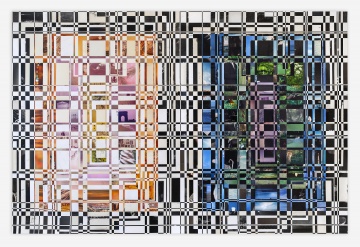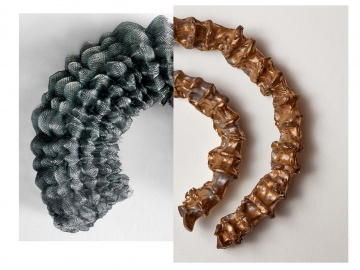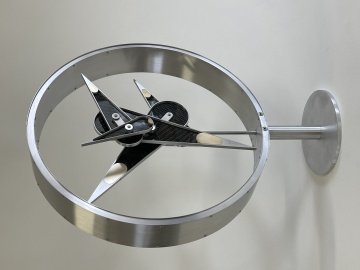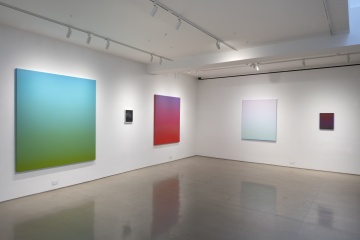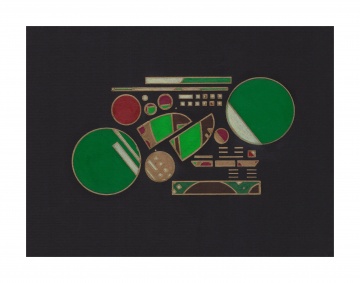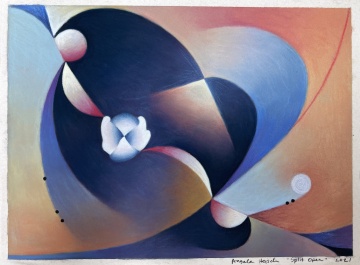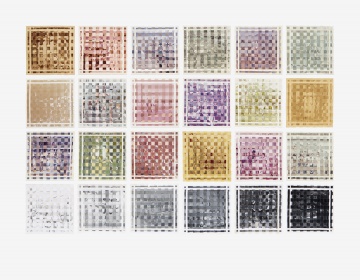Davidson Gallery
521 West 26th Street
New York, NY 10001
By Appointment
212 759 7555
New York, NY 10001
By Appointment
212 759 7555
Artists Represented:
Sophie Bouvier Auslander
Sophie Bouvier Auslander
Nicky Broekhuysen
Nathan Ng Catlin
Carlos Cruz-Diez
Pedro S. De Movellan
Heather Hart
Glendalys Medina
Sam Messenger
Jean-Pierre Roy
Boo Saville
The Estate of Mary Ann Unger
Thomas Witte
Sanford Wurmfeld
Works Available By:
Harry Bertoia
Harry Bertoia
Alexander Calder
George Rickey
Jesús Rafael Soto
Victor Vasarely
Tom Wesselmann

Entrance, Maxwell Davidson Gallery
Nicky Broekhuysen
The Wind in High Places
May 18, 2023 - June 24, 2023
Davidson Gallery is pleased to present The Wind in High Places, an exhibition of new paintings on linen by Nicky Broekhuysen (b. 1981, Cape Town, RSA). While she has not abandoned her signature use of 1s and 0s, this show – Broekhuysen’s third with the gallery – marks a shift in her practice. That shift was initiated in 2019 when she moved from Berlin to the French Pyrenees. The change from the city to nature was also a move from noise to quietness. In the quietness of the mountains, Broekhuysen found new things to hear and new conversations to have.
In the years since adopting her use of binary code as building blocks for her work, much has changed. As we move from a binary world to a world of quantum computing and artificial intelligence, that notion of a binary world must move too. Broekhuysen’s work has always been about change and the possibility for change inherent in the potential of the one and zero of binary code. By placing the ideas of ‘binary’ to the side, the artist began to see the 1 and 0 more in terms of their original forms: a line and a circle. The line began to embody the idea of the individual or separateness – quite literally “I” – and the circle as a representation of the connected whole.
Change from the perspective of living in a city can often appear rapid and brutal. In nature, however, there is a subtlety to the way that change reveals itself. There is a slowness to the passing of time: one has to pay attention to catch the many subtle moments of transition as the colors change from one season to the next. In The Wind in High Places, light, form, and color meld to create barely perceived land- and skyscapes. Mountains seem to emerge from mist as background colors combine with Broekhuysen’s pointillist method. The palette used in this exhibition captures the metamorphosis of the mountain slopes from the coolness of winter to the first vibrant green moments of spring. For in nature, we indeed feel home and as we locate ourselves (the “I”) within the circle, we again feel ourselves as part of a collective world plugged into the network of nature.
Nicky Broekhuysen was born in 1981 in South Africa. At the age of 13 her family moved to New Zealand where she completed her studies. After graduating with a Bachelor of Fine Arts Degree from Auckland University, she moved to Shanghai, China in 2006. It was in Shanghai that she first began working with binary numbers 1 and 0. In 2008 Broekhuysen moved to Berlin, Germany where she continued to develop her language of binary code, exhibiting both in Berlin and internationally for the following 11 years. Recently, in 2019 she has relocated her studio to The Pyrenees in France to be closer to nature and where she continues to create and exhibit.
George Rickey
A Survey
April 6, 2023 - May 13, 2023
Davidson Gallery presents, George Rickey: A Survey, an exhibition of works by acclaimed sculptor George Rickey. This show marks the 18th solo exhibition at the gallery for George Rickey, dating back to their first collaboration in the 1970s. Rickey’s work runs the gamut from intimate and delicate to monumental. Throughout his career, George Rickey refused to be pigeonholed, constantly reimagining kinetic sculpture and always trying to define motion in ways that other artists did not. From his earliest hanging sculptures, reminiscent of Alexander Calder’s mobiles, to his first major outdoor work which is now in the collection of MoMA, Rickey constantly changed scale, material, form, and technology, but always with a throughline of motion that was his legacy.
Rickey approached his art with a constructivist mindset, he was both a collector of Constructivist material (his collection of Constructivist works is now at the Neuberger Museum) and close friends with Antoine Pevsner and Naum Gabo. His most well-known works – those made of brushed stainless steel forms – epitomize the austerity of Constructivism, but also the forward-looking, self-aware stance that art is and must be socially integrated. Rickey’s work, cutting through space, defining motion, intimating identifiable forms while maintaining its abstraction, remains masterful and contemporary.
Joe Rudko
Afterimage
February 23, 2023 - April 1, 2023
Davidson Gallery is pleased to present Afterimage, a solo exhibition for visual artist Joe Rudko. Rudko’s work blends techniques of photography, painting, drawing, and collage. Each new work is composed of found images – “forgotten photographs” as the artist terms them – which are then disassembled and meticulously rearranged to create rippling patterns and visual vibrations.
Rudko’s process of photomontage is informed by the more traditional processes of quilting and mosaics, but also by more modern digital forms of manipulation. In his use of photographs, Rudko is coopting and repurposing other people’s uses of the medium as a means of remembrance and memorialization, sometimes using the content or form as an outline or starting point for his own work, and sometimes abstracting it beyond its own recognizability. The show’s title, Afterimage, refers to the perceived remnants on the retina of what is no longer visible; an afterimage itself is an illusion, and can take the form of an outline, color, light, or form. Much like a photograph, afterimages can be negative or positive, and vary widely in detail. Ultimately, they are not accurate representations of what was.
The source photographs for Afterimage were collected from the basements and attics of friends, family, and a variety of internet vendors. They are comprised of over a hundred years of printed photographs and their varied surfaces depict diverse subjects: a mountain landscape, a resting hand, a waterfall, a camera flash, or even an unfocused blur. Black and white prints are intertwined with color fragments from the 1990s, and images are reversed to reveal product branding. Handwritten annotations such as “flowers”, “me”, and “genuine” are scattered across the surface, adding a tactile and historical aspect to the work. The palette of recycled tones creates an alchemy of materials, celebrating the photograph as a malleable document of memory, ever-changing in response to the present moment.
Joe Rudko lives and works in Seattle. His work is in the permanent collection of The Getty Museum, Portland Art Museum, Museum of Fine Arts Houston, Tacoma Art Museum, and most recently in the Morgan Library & Museum in New York. He received his BFA in Photography and Drawing from Western Washington University in 2013. This is his third solo exhibition with Davidson Gallery.
Eve Biddle | Mary Ann Unger
Generation
January 12, 2023 - February 18, 2023
Davidson Gallery is delighted to present Eve Biddle | Mary Ann Unger: Generation, a two-person exhibition by American artists Mary Ann Unger (b. 1945, New York; d. 1998, New York) and her daughter, Eve Biddle (b. 1982, New York), curated by Ylinka Barotto.
Following Mary Ann Unger's acclaimed first US retrospective at the Williams College Museum of Art, the exhibition at Davidson Gallery features a selection of works by both Unger and Biddle, marking the first comprehensive presentation of Biddle's work. While highlighting the artists' distinctive practices in sculpture, drawing, and printmaking, it celebrates the creative and aesthetic dialogues that stemmed from their intimate and potent familial ties as mother and daughter.
Heather Hart
She Cuts Through Worlds
November 3, 2022 - December 22, 2022
Davidson Gallery is proud to announce the opening of She Cuts Through Worlds, a solo exhibition by Heather Hart. Hart’s work exists at the junction of art, architecture, performance, and theory. Hart addresses and challenges current and on-going socio-political, racial, and economic climates using space as her medium. The use of space and spaces is both a constructive, additive process, as well as a reclamation or a carving-out of area – convexity as a declaration of being. Hart’s work implies the possible through architecture, using territories and thresholds as means to challenge our presumptions about our relationships with them.
Those relationships are the starting points for She Cuts Through Worlds. Hart looks at how we as people inhabit space, but also feel entitled to it, and how that contributes to identity and a sense of self. The first part of the exhibition concerns Spaces and, specifically, Black Spaces. Hart “quotes” shards of objects or built environments that are part of Black narratives, cultural touchstones and icons, creating a visual lexicon whose vocabulary includes Oprah’s couch, Uhura’s workstation, Carrie Mae Weems’s kitchen, and the balcony of the Lorraine Motel among others. They are moments in time, but exist perpetually in collective consciousness and identity. The Spaces themselves juxtapose a collection of the 3D-printed “phrases”, resting them in and upon wooden structures, each tailored to the dialogue of Black Spaces they contain.
Additionally, Hart has included Fragments, sculptures that resemble shingled rooftops – reminiscent of her large-scale installations – that refer to liminality in all its manifold definitions. They are the space between the elements and the indoors, the transition from architecture to art, and a reconsideration of scale. Named after crystals, they connote growth and change, transformation, topography and transmogrification.
Upstairs in the gallery’s rooftop space, viewers arrive upon a larger rooftop pyramid outside on the terrace, visible through a large picture window. However, a handmade wall cuts the gallery space in two, directing us away from the sculpture to an opening that allows access to the outside. It is there that viewers are confronted by the wall once again, dividing the terrace itself. Light permeates the slats, but the sculpture is unreachable. On closer inspection the rooftop is an eight-sided star, a pattern from 19th-century quilting that represents the North Star – illumination, direction, freedom. That unattainable liberty in the form of a rooftop too small to live under creates an un-enterable shrine offering unusable asylum.
Heather Hart (b. Seattle, WA, lives and works in Brooklyn, NY) is an interdisciplinary artist exploring the power in thresholds, questioning dominant narratives, and creating alternatives to them. Hart’s work has been exhibited at the Queens Museum, Storm King Art Center, Albright-Knox Museum, The Kohler Art Center, NCMA, Eastern Illinois University, Seattle Art Museum, Brooklyn Museum, University of Buffalo, and University of Toronto, Scarborough among others. She was awarded grants from Anonymous Was A Woman, the Graham Foundation, Joan Mitchell Foundation, and the Jerome Foundation, NYFA, and Harpo Foundation. Hart co-founded Black Lunch Table in 2005 and has won a Creative Capital award, Wikimedia Foundation grants, an Andrew W. Mellon Foundation grant and an Andy Warhol Foundation of Art grant with that project. Hart is an Assistant Professor at Mason Gross School for Art + Design, a member of the Black Trustee Alliance for Art Museums, an external advisor for AUC Art Collective, and a trustee at Storm King Art Center. She studied at Skowhegan, Whitney ISP, Cornish College of the Arts, Princeton University and received her MFA from Rutgers University. Hart was a 2021-2022 Fellow at the Radcliffe Institute for Advanced Study at Harvard University. This is her first exhibition with Davidson Gallery.
Tiffany Chung
Terra Rouge: Circles, Traces of Time, Rebellious Solitude & Archaeology for Future Remembrance
September 8, 2022 - October 22, 2022
Davidson Gallery is honored to present two concurrent solo exhibitions by internationally acclaimed artist Tiffany Chung. The exhibitions will be featured on Davidson Gallery’s two floors and will continue Chung’s sociopolitical and environmental explorations into the lattice-work relationships between humankind, the lived landscape, and the natural world. Titled Terra Rouge: Circles, Traces of Time, Rebellious Solitude, the first of the two shows features all new cartographic drawings and paintings on vellum. Terra Rouge focuses on the Bình Long–Phước Long plateau region (present day Bình Phước province) in southwest Việt Nam, on the border with Cambodia. The history of the area is ramose: it was the site of some of the most violent fighting of the 1972 Easter Offensive during the Vietnam War, it is where some of the first rubber plantations were built by French colonialists at the end of nineteenth century, and is home to archaeological discoveries of Neolithic circular earthworks. It is these excavated sites, dating from 2300-300 BCE, that serve as the catalyst and subject matter for Chung’s new series, creating a visual reference but also a mystery to be investigated. The civilization that existed there for nearly 2000 years was ultimately abandoned. Chung explores how the populace lived, why they left, and what could have happened if they had stayed.
In a separate but connected exhibition, the tenth-floor gallery will feature Archaeology for Future Remembrance, an extant but continuous series of work that delves into Chung’s work around the Thủ Thiêm district of Sài G n (Ho Chi Minh City). Thủ Thiêm was a residential zone that was razed by the Vietnamese government beginning officially in 2002, displacing tens of thousands of its denizens in favor of a sprawling master-planned urban development project. In an effort to preserve the memory of the original site and its people after a prolonged and violent eviction, Chung excavated the site, unearthing evidence of life: fragments of buildings, shoes, and household items. Additionally, the artist has added her own drawings, video, and an accompanying series of twenty-six glass plates etched with text referencing the seemingly inexorability of progress and reclaiming land that is labeled “wasteland” all under the guise of colonialism and nation-building alike.
Both exhibitions wrestle with notions of nation-building, modernization, and expansion as inevitable even as the concepts wholly ignore the personal and the historical. Set against the backdrop of the ever- changing skyline of New York City – itself reclaimed land – Archaeology for Future Remembrance argues that Vietnam’s treatment of its own people in Thủ Thiêm echoes the dehumanizing and marginalizing mindsets of its own colonial occupiers. Meanwhile, the maps of circular earthworks in Terra Rouge: Circles, Traces of Time, Rebellious Solitude suggest a quieter but clearly legible look at how ancient communities may have suffered similar fates to modern ones, positing possible reasons for abandoning the site while also scouring the evidence for possible ways to change our own mistakes while also avoiding the ones made over 2000 years ago.
Marcus Vinícius De Paula
Superluminal
May 6, 2022 - June 11, 2022
The exhibition features sculptures made over the last two years and is an apex for the multidisciplinary artist with a career surrounding light. The works draw inspiration from his father, a Brazil-born NASA engineer, and examine relative notions of time across our lives, source materials, and the cosmos.
Pedro S. de Movellán
Parallax
May 5, 2022 - June 11, 2022
Davidson Gallery presents Parallax, a solo exhibition of new kinetic sculpture by artist Pedro S. DeMovellan. The main body of work in Parallax is seven outdoor sculptures ranging in height from seven feet to over eleven feet. It is the first time in his career that De Movellán has dedicated so much of his practice to so many large-scale works. All seven outdoor pieces, as well as several smaller indoor sculptures and working maquettes, are featured on Davidson Gallery's two outdoor sculpture terraces and light-filled top floor gallery.
Nathan Ng Catlin
What Goes on Behind a Windowpane
March 24, 2022 - April 30, 2022
Davidson Gallery presents What Goes on Behind a Windowpane, an exhibition of new work by Nathan Ng Catlin. The work in the exhibition includes painting, ceramic, stained glass, and found objects, each indicative of Catlin’s signature clear line style and his ability to work in virtually any medium. The title of the exhibition and many of the works in it are taken from the Charles Baudelaire poem “Windows” but references the artist’s – and every person’s – experience over the past two years. Windows appear in nearly every work, creating physical and visual thresholds through which people see and are seen, creating a voyeuristic effect as the subjects do not know they are being watched. Like many artists, Catlin spent the majority of the pandemic working in his studio or sitting at home, looking out the window at a world that seemed to stand still, even as the inexorable march of time and nature continued to run their course. The stained glass is most obviously associated with church windows, which Catlin subverts to make profane the normally sacred narrative that they impart, while also sanctifying the interiority that we were all forced to experience.
While uncertainty reigned so too did civil and social unrest, creating a metaphysical window through which we viewed the world, and saw ourselves as though in partial reflection. Catlin’s work always maintains a certain degree of allegorical mystery. Each image is a frozen snapshot that exists in a moment just before or after a significant event, following a narrative known in full only to the artist, but understandable to all as part of the human condition. The sense of being watched by unseen eyes, the inherent eeriness of being alone in the woods, or even the way we distract ourselves from the real-world events going on just outside. As Beaudelaire wrote in “Windows”, “What we can see in daylight is always less interesting than what happens behind a windowpane,” Catlin captures this emotion as he deftly transitions between different mediums and scale to achieve a singular new series.
Nathan Ng Catlin is a multi-disciplinary artist who lives and works in Brooklyn, NY. As a mixed-race first-generation Asian American from southern California, Catlin is interested in the complex narratives that arise from distinctions (culture, views on morality, etc.) that bring people together and separate them. His work is representational and figurative, featuring human interactions that draw inspiration from classical paintings, comic books, and tattoos. Catlin received his BFA in printmaking from the San Francisco Art Institute in 2007 and his MFA from Columbia University in 2012. He works in multiple mediums including printmaking, painting, ceramics, stained glass, and mosaic. This is his second solo exhibition with Davidson Gallery.
Boo Saville
The Smoke Detector and the Watchtower
November 11, 2021 - January 21, 2022
Davidson Gallery proudly presents The Smoke Detector and the Watchtower, an exhibition of new paintings by Boo Saville. The exhibition features 15 new color field and dichromatic figurative works by Saville painted over the last year and a half. The show title is taken from the book The Body Keeps the Score, by Dr. Bessel Van der Kolk, a psychiatrist and leading scholar and researcher of post-traumatic stress and its effects. Saville read Van der Kolk’s book during the lockdown in the UK and was drawn to the ways in which the book explores how traumatic events and experiences change the way people perceive the world.

Thomas Witte
Centerpiece
September 9, 2021 - October 9, 2021
Davidson Gallery is pleased to present Centerpiece, a solo exhibition of new work by Thomas Witte. Thomas Witte is an American contemporary artist who currently lives and works in New Jersey. Witte works almost exclusively with cut paper as his primary medium and a scalpel as his main tool. Though perhaps best known for using a dichromatic pallet of pristine white paper and a contrasting color, Witte has created six paintings – this time in full color – for his third solo exhibition at Davidson Gallery. Each painting was made between 2020–2021, a time that will be remembered for the many permanent changes society has undergone in light of the ongoing global pandemic.
Nostalgia is fundamental to Witte’s work and, at a time when free movement, travel, and human interaction became legally limited, the subjects of his recent paintings become even more pertinent during newly imposed restrictions. Not only are the images Witte depicts evocative of past memories, but their very creation is borne from them. The starting point is always based upon 35mm slide photographs, which Witte collects in the thousands. The source material and process of making the paintings are not necessarily important to the reading of the finished works, but as the paintings themselves are so deliberate, scrupulous, and time intensive, it is impossible to ignore; the opposite of the snapshot on which they’re based.
The arrangement and subject matter of the works are formed as Witte draws the details in, then removes the images as paper-cut collages, or adds them as decoupage. Each constituent component is an abstract which, when orchestrated together, forms far more than the sum of its parts.
The delicate and fragile paintings as objects were entirely made by hand. The artist carefully tinted sheets of lightweight gossamer like paper – acid free tissue paper that is chosen for its delicate and translucent quality – with watercolor washes of solid, single blocked, permanent color. Witte then hand cuts these sheets with his preferred Japanese scalpel and builds them up as layers of color. With the most modest and basic of medium – paper and color wash – Witte assembles a highly varied texture of detail, contrast, and tone. The colors and character evoke an atmosphere and impression of a particular time and place, along with the unchanging presence of the camera's cropping lens and the artist’s editorial eye.
Centerpiece includes scenes of arranged, cut flowers as a recurring device, with the hint of activity going on, always just or partially out of frame. They leave the subject matter open to interpretation by the viewer in any context, Meanwhile the still-life motif resonates through art history, having been used to imply all forms of basic human emotions. The use of the familiar trope with the intimation of life going on around it, recontextualizes the use of artistic subjects. The Centerpiece is both the silent focus and the rebus, rife with meaning
The new body of work presented in this exhibition clearly demonstrates a commitment to concept, form, and process by Witte, taking into account the long traditions of paper and painting, and is an important milestone in the artist’s oeuvre.
Glendalys Medina
Gratitudes
May 13, 2021 - July 10, 2021
In 2020, as the pandemic gripped the world and our lives went on pause, I found myself in a hopeless state. After about a week in bed, I asked my mother to borrow her dog to motivate me to get up and care for something outside of myself. I gave myself a drawing exercise on our 15-minute walks; to find something to be grateful for, to appreciate the ability to see and cultivate an attitude of gratitude. After taking minutes to observe an item or experience, I would come up to my studio and put the color down as a document of that moment. Those moments created this series of color studies. To this day, when I am feeling down, I go out and enact the same exercise.
Glendalys Medina, 2021
Nicky Broekhuysen, Pedro S. de Movellán, Angela Heisch, Sam Messenger, Boo Saville, Thomas Witte
Hope Springs Eternal
April 8, 2021 - May 1, 2021
Davidson Gallery presents a group exhibition curated by Natasha Schlesinger. As the English poet Alexander Pope wrote in the 18 th century, “Hope springs eternal in the human breast”. When turmoil rages on multiple levels all around us, it is hope that gives us the strength to go on and look forward to the future. Spring brings regeneration and renewal, so we turn to the future and see the light at the end of the proverbial tunnel. The human need to create and the human ability to appreciate art connect us to boundless possibilities and potential for something better, for something more. The artists in this exhibition use their preferred mediums to express abstract concepts such as hope, longing, spiritual renewal, and human potential for love in their works. We, as viewers, connect to these concepts through their works and experience a re-awakening of our senses and a renewal of hope for the future.
Joe Rudko
Processing
September 17, 2020 - November 21, 2020
Davidson Gallery is pleased to present Processing, an exhibition of new works by Joe Rudko. Rudko’s photographic sensibilities extend past his training in the medium into the realms of sculpture, collage, and painting. The title of the exhibition is an obvious nod to the procedure of creating traditional photography, but has a manifold meaning - virtually all of the works in the show were created in 2020, a year of social and economic upheaval, and a worldwide pandemic.
As such, Processing also refers to the ways and means by which human beings navigate and contend with our current situation, and current events. It is also a term that addresses how we, as viewers, perceive art and digest what we see. This is especially true with Rudko’s work - his disassembly and reassembly of vintage and found photographs reimagines what it means to capture and create images, much as photography in its earliest days upended how people perceived painting and other traditional representative art.
Many of the works in the exhibition are made up of vintage photographic duplicates, repurposed, reconfigured, and reimagined to produce works that are not quite figurative nor abstract. In many cases, they clearly depict people or body parts, but have been rearranged to appear as if in mid-transformation, metamorphosing into a wholly discrete new form. Still others use the color or shape of the original photographs to construct some new, previously unforeseen shape, reconsidering (and at times subverting) the original photographer’s intent. For example, the work Square Knot creates counterposed gradients of colors intertwining in reference to the undeniable link between a collective past, the not-so-distant past, and the present moment.
Joe Rudko is a graduate of Western Washington University and has shown in both solo and group exhibitions throughout the Northwest including PDX Contemporary Art (Portland, OR), Roq La Rue (Seattle, WA), LxWxH (Seattle, WA), Photo Center Northwest (Seattle, WA), Whatcom Museum of Art (Bellingham, WA), and Greg Kucera Gallery (Seattle, WA), as well as Von Lintel Gallery (Los Angeles, CA). He has been the recipient of the Future List Award and two Art Walk Awards from City Arts Magazine as well as the Vermont Studio Center Fellowship Award. His work was featured on the cover of indie rock band Death Cab for Cutie’s 2015 album Kintsugi and is included in the collections of the Museum of Fine Arts Houston, Portland Art Museum, Fidelity Investments, and the private collections of Dorothy Lemelson, James and Susan Winkler, and Driek Zirinsky. Rudko lives and works in Seattle, WA. This is his second solo exhibition with Davidson Gallery.
Group Exhibition
#WFH - Online Exclusive
March 16, 2020 - May 2, 2020
As we all grapple with the reality of COVID-19, Davidson Gallery will be self-isolating like many of you; as such, we want to bring the best art to you. Follow us for #wfh art exhibitions updating on a daily basis, including new works, exclusive behind-the-scenes content, artists' studio visits, and interviews.

Purvis Young
Under a Concrete Sky
February 6, 2020 - March 21, 2020
Davidson Gallery presents Under a Concrete Sky, an exhibition of work from acclaimed painter Purvis Young. The show title references the Miami neighborhood of Overtown, a predominantly black, low-income neighborhood where Young lived, worked, and was a community fixture until his death in 2010. So named for the interstate that was constructed over the area in the 1960s, Overtown was as important to Young as he was to his neighborhood. It is impossible to separate the artist from the district – despite creating work that referenced national and even global issues, Young was decidedly of and for Overtown, befriending its denizens and becoming its de facto artist-in-residence.
This show – the first for Young at Davidson Gallery – represents a wide range of such subjects, including pregnant women, cities and cars, horses, boats, and slave imagery. The works were all acquired directly from the artist in the 1990s and 2000s.
Young was an extraordinarily prolific painter who was entirely self-taught. Despite never even attending high school, his references to canonical art history are undeniable, and his lack of formal education was hardly a limiting factor. Young devoted himself entirely and obsessively to painting, using whatever materials were at hand, including plywood, vinyl siding, furniture, and signs. Despite a tumultuous professional career which left him virtually destitute at the time of his death, his work has been recognized and collected by many of the country’s most respected institutions including the Metropolitan Museum of Art, the Smithsonian, the Philadelphia Museum of Art, and LACMA, to name but a few.
Tom Wesselmann
September 12, 2019 - October 26, 2019
Impossible Objects: Jenna Krypell, Ricardo Paniagua, Richard Roth
June 6, 2019 - August 3, 2019
Thomas Witte
If These Memories Were Mine
April 11, 2019 - May 24, 2019
Mary Ann Unger
Fluid Line: 1968-83
January 10, 2019 - February 16, 2019
Calder/Rickey
September 13, 2018 - October 27, 2018
Darren Lago
Who's Afraid of Red, White and Green
May 10, 2018 - June 16, 2018
Torkwase Dyson
March 15, 2018 - May 5, 2018
Sophie Bouvier Ausländer
Avalanche
January 18, 2018 - March 10, 2018

 Back to all Member Galleries
Back to all Member Galleries


